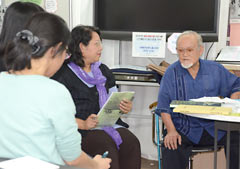Nakachi looks back on the landowners’ struggle against the U.S. military in the post-war period

On September 20, at the exhibition at Okinawa City Gallery Postwar Culture and History called "Histreet," Nakachi explains the history of U.S. military land use and the landowners' struggle after the war.
October 5, 2012, Ryukyu Shimpo
On September 20, at the exhibition at the Okinawa City Gallery Postwar Culture and History called “Histreet,” the Okinawa Municipal Historiographic Office held its regular monthly meeting of the Society for Postwar History. Meijo Nakachi, the editor in chief of the 30th anniversary issue of the magazine published by the Okinawa City Federation of Landowners Association of Land used for Military Purposes related stories about the military land in Okinawa and landowners after the war.
Nakachi is from Awase in Okinawa City. Awase was occupied by the U.S. military from April 1945. The occupation forces seized land and in August 1945 constructed an air-base to be used for attacking the main islands of Japan. Nakachi explained the crisis that the landowners faced at the time: “We had survived the war, and the U.S. military was distributing food to us. We were grateful to them until they started to occupy the land and stopped paying for the lease.”
Nakachi said that he studied the clauses of the Hague Convention with the late activist Zenko Yamashiro, who was a member of the Legislature of the Government of the Ryukyu Islands, and the late Choko Kuwae, who was Okinawa City mayor and the president of the Okinawa Prefectural Federation of Landowners Association of Land used for Military Purposes. They understood the legal basis under the Hague Convention for landowners to claim compensation for the lease of the land because the convention covers the treatment of prisoners of war and the handling of occupied land.
Looking back on those days he said, “While there were fierce struggles such as that at Isabama, we launched a silent struggle. The proposed lump-sum payment that the U.S. military implemented triggered strong opposition among the Okinawan people, because they feared that Okinawa would then belong to the United States. This led to a struggle that became known as the shimagurumi-toso (all-island struggle) and as a result, the lease contract currently used was established.
(English translation by T&CT, Kyoko Tadaoka and Mark Ealey)
Previous Article:Women solemnly dedicate traditional dance Chibana Usudeku
Next Article:Two U.S. sailors arrested on suspicion of assaulting woman
[Similar Articles]
- Another 174 landowners join the already more than 4000 who will not renew their contracts for U.S. military use
- Landowners of U.S. base-used land in Okinawa increasingly reside outside the prefecture
- US military returns 51-hectare housing area at Camp Zukeran
- Archival papers suggests U.S. military carried out nuclear weapon drill in Okinawa during 1960s
- Fundraising begins to repair and preserve “Solidarity Dojo,” symbol of resistance to US military
 Webcam(Kokusai Street)
Webcam(Kokusai Street)


